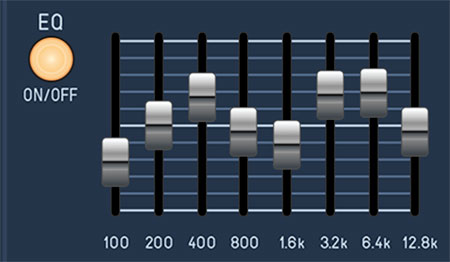
Sines features studio-quality effects including distortion, mod effects, delay (including our nifty Stardust tape delay algorithm), and reverb (with our awesomely huge Galactic algorithm.) Best of all, effects parameters are fully modulatable using the Mod Matrix section.
Distortion

Sines distortion effect operates in dual-mono mode; that is, it doesn't stereo-ize incoming mono signals, but incoming stereo imaging is maintained - the stereo image isn't summed to mono. You can hear this for yourself by setting up a patch with two or more oscillators and moving the Pan sliders.
On/Off- Enables and disables distortion effect.
Select (Sel) button- Selects effect mode.
Tube- This is the mellowest distortion mode. Use it to add just little bit of vintage hair to sounds.
Grunge- Loud, aggressive, and raunchy, like Soundgarden.
Fuzz- Also aggressive and raunchy, but more fizzy and vintage, like uh... In-A-Gadda-Da-Vidda (baby).
Sample Crush- This actually changes the sample playback rate - going all the way down to 500 Hz (not kHz, but Hz!), so it can make a real mess.
Tone & Level- Not a distortion effect at all - in fact the Drive knob is disabled in this mode, but the Tone knob is usable as a flexible pre-other-effects one-knob tone control.
Drive- Amount of distortion.
Tone- Relative brightness of tone.
Level- Overall volume; this doesn't affect the amount of distortion. Increasing drive will cause an overall volume increase, Level can used to balance things out.
Mod FX

Mod FX features chorus, flanger, and rotary speaker modes. Mod Effects operate in stereo, that is, incoming mono audio will be stereoized, but dry panned audio will maintain its pan position.
On/Off- Enables and disables distortion effect.
Select (Sel) button- Selects effect mode.
Chorus
Flanger
Phaser
Rotary Speaker
Chorus and Flanger are very closely related, with the general difference being that Flangers use a shorter time range and some amount of feedback (which intensifies the "jet-flyby" effect), whereas choruses utilize a comparatively longer delay, and no feedback.
Rate- Sets the modulation speed from 0.01- 8 Hz. The LED light will flash to show the curent rate. When in Rotary Speaker mode, the Rate knob acts as a two-position slow/fast switch. Settings from 0-50% will be slow, and 50% to 100% will be fast. When the rate is changed, the rotary effect accelerates and decelerates just like a real rotary speaker. The mod wheel or other mod sources can be assigned to alternate the speed setting using the Mod Matrix.
Depth- Sets effect depth, i.e. the amount of modulation. The Depth is disabled in Rotary Speaker Mode.
Feedback- Sets the amount of internal feedback when in Flanger mode. Because chorusing and rotary speakers doesn't make use of feedback, the Feedback control is disabled when in Chorus or Rotary Speaker modes.
Delay

A handy and DAW sync-able delay with multiple effect modes.
The delay operates in dual mono so incoming stereo imaging (i.e. panning oscillators) is maintained - the stereo image is not summed to mono. It can widen the stereo image of incoming mono or stereo signals by using the Spread knob described below.
On/Off- Enables and disables delay effect.
Sync- Enabling the Sync switch locks the delays time to master tempo. When engaged, the Time knob snaps to note values ranging from 1/64th note triplet to 8 beats. Sync mode locks to the tempo in the top toolbar when using the standalone version or the current project tempo when using the plug-in version in a DAW.
Time - Sets delay time, from 1 to 2000 ms. If the Sync button is enabled, time settings snap to synchronized note values (see preceding Sync switch). The ms display always shows the exact delay time in milliseconds.
Mix- Balances the level of dry and wet signal.
Select (Sel) button- Selects effect mode.
Stereo Delay- A standard, clean sounding delay.
Ping Pong Delay- Echoes alternate between audio channels.
Tape Delay- Reproduces the effect of a vintage "space echo" tape delay.
Feedback- Routes the output to the input for additional repeats.
Damp- Attenuates high frequencies as the knob amount is increased. Not only does this create more natural sounding decays, it also reduces the "stacking" effect that occurs with high feedback levels.
Spread- This subtracts delay time from the left channel and adds time to the right channel, creating a wide stereo effect, as well as preventing echoes from "piling up" in the center of the image. Note that the subtracted and added delay effectively offsets the overall delay time setting with each repeat, so long delays combined with high feedback settings can become off time (just back off the Spread knob a bit to fix).
Reverb

A smooth, studio-quality stereo reverb. The stereo implementation allows it to be used to stereoize mono (i.e. centered) sounds, but panning positions are retained.
On/Off- Enables and disables reverb effect.
Mix- Balances the level of wet/dry reverb signal.
Reverb Type- Allows selection of Spring, Room, Plate, Hall, and Galactic reverb algorithms. In case you're wondering, Galactic mode is a mega large, super vibey, super-spacey algorithm that you'll dig.
Decay- Sets the length of reverb release time/size of room.
Damp- Attenuates high frequencies as the knob amount is increased.
Graphic EQ

Ok, who else gives you a cool graphic EQ on a synth? This is an eight-band EQ with 12 dB of cut or boost for each band, across the master output of the entire synth.
If you've created a patch by stacking a ton bunch of pure sine waves in different octaves and tunings (such as the Templates>Harmonic Series factory preset), the bass can get pretty large - the graphic is nice for getting that under control.
On/Off- Enables and disables EQ effect.
Band Sliders- Cuts or boost up to 12 dB at 100, 200, 400, 800, 1600, 3200, 6400, and 12,800 Hz. (Try modulating these with an LFO in the Mod Matrix!)
Remember that all effects parameters can be modulated via the Mod Matrix, so you can get all crazy and Hainbach-y.